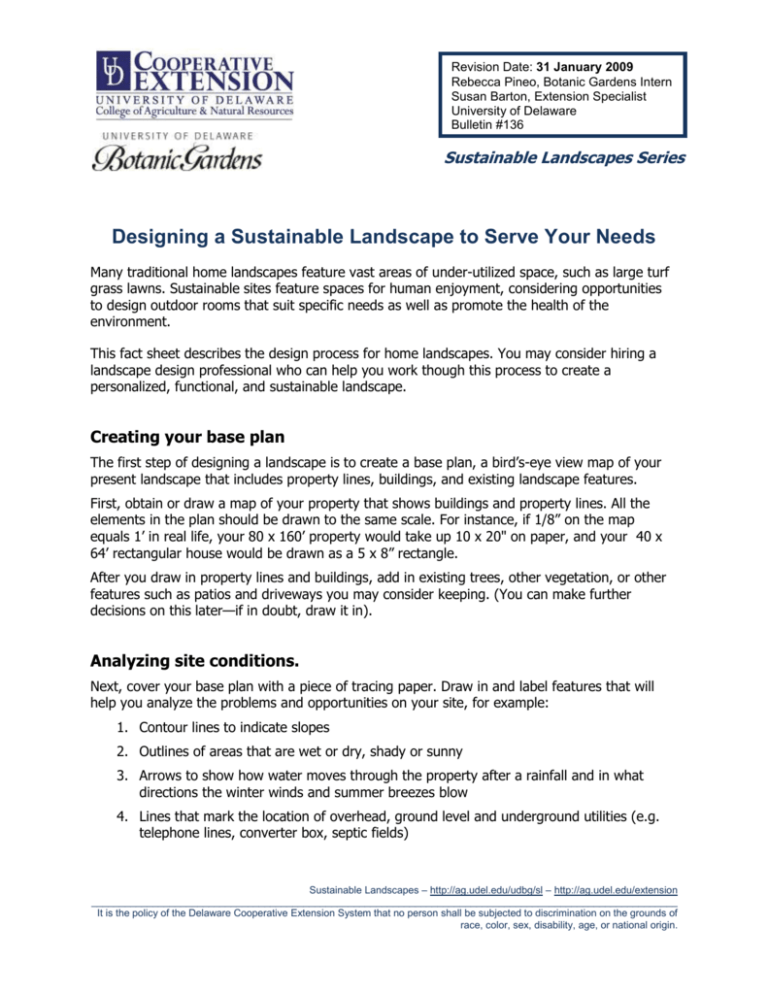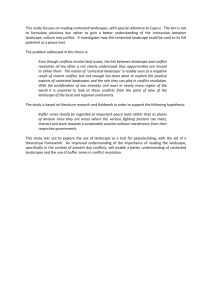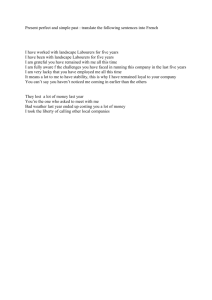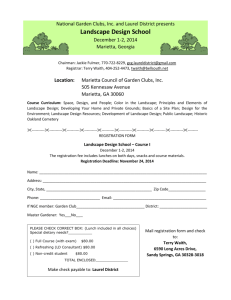
Revision Date: 31 January 2009
Rebecca Pineo, Botanic Gardens Intern
Susan Barton, Extension Specialist
University of Delaware
Bulletin #136
Sustainable Landscapes Series
Designing a Sustainable Landscape to Serve Your Needs
Many traditional home landscapes feature vast areas of under-utilized space, such as large turf
grass lawns. Sustainable sites feature spaces for human enjoyment, considering opportunities
to design outdoor rooms that suit specific needs as well as promote the health of the
environment.
This fact sheet describes the design process for home landscapes. You may consider hiring a
landscape design professional who can help you work though this process to create a
personalized, functional, and sustainable landscape.
Creating your base plan
The first step of designing a landscape is to create a base plan, a bird’s-eye view map of your
present landscape that includes property lines, buildings, and existing landscape features.
First, obtain or draw a map of your property that shows buildings and property lines. All the
elements in the plan should be drawn to the same scale. For instance, if 1/8” on the map
equals 1’ in real life, your 80 x 160’ property would take up 10 x 20" on paper, and your 40 x
64’ rectangular house would be drawn as a 5 x 8” rectangle.
After you draw in property lines and buildings, add in existing trees, other vegetation, or other
features such as patios and driveways you may consider keeping. (You can make further
decisions on this later—if in doubt, draw it in).
Analyzing site conditions.
Next, cover your base plan with a piece of tracing paper. Draw in and label features that will
help you analyze the problems and opportunities on your site, for example:
1. Contour lines to indicate slopes
2. Outlines of areas that are wet or dry, shady or sunny
3. Arrows to show how water moves through the property after a rainfall and in what
directions the winter winds and summer breezes blow
4. Lines that mark the location of overhead, ground level and underground utilities (e.g.
telephone lines, converter box, septic fields)
Sustainable Landscapes – http://ag.udel.edu/udbg/sl – http://ag.udel.edu/extension
_________________________________________________________________________________________________________
It is the policy of the Delaware Cooperative Extension System that no person shall be subjected to discrimination on the grounds of
race, color, sex, disability, age, or national origin.
5. Stars to indicate good views you want to preserve and X’s to show bad views you want
to hide
Design program
Using your site analysis as a guide, make a list of your wants and needs, special problems you
may need to solve on your landscape, and goals for sustainability. This is called your design
program, and it will serve as a checklist of features to consider in your design. For example,
your program may include:
Wants and Needs:
Problems to Solve:
Goals for Sustainability:
patio for entertaining
garbage/recycling bin
storage
vegetable garden
play space
utility space for
working outdoors
space for barbequing
water feature (pond,
fountain)
aesthetic interest
throughout the
changing seasons
compost area
windbreaks to direct
summer breezes and
protect from winter wind
shade for summer
comfort and lower
cooling costs
privacy from neighbors
frame views of off-site
landscapes
screen undesirable views
maximize sun exposure
during the cold seasons
reduce glare from
windows and water
bodies
direct movement of
people to certain
entryways
on-site stormwater
management
erosion control
minimize grading
preserve existing
vegetation
low-maintenance
maintain and create
wildlife habitats
Explore the University of Delaware Botanic Gardens’ Sustainable Landscapes website at
http://www.ag.udel.edu/udbg/sl/ for other ways to promote sustainability in your landscape.
Designing outdoor rooms
Once you’ve developed your lists of wants and needs, it is time to consider how these might be
fulfilled by specific spaces in your landscape. Think of these spaces as “outdoor rooms,” with
each serving a specific function—much like the kitchen, bathroom, bedroom, and hallways have
specific functions in your house. For instance, some of the outdoor rooms you might include are
Sustainable Landscapes – http://ag.udel.edu/udbg/sl – http://ag.udel.edu/extension
_________________________________________________________________________________________________________
It is the policy of the Delaware Cooperative Extension System that no person shall be subjected to discrimination on the grounds of
race, color, sex, disability, age, or national origin.
an entertaining space, a place for children to play, an area for barbequing, and an arrival space
for people to stand while knocking at your front door.
For this part of the design process, you should cover your base plan and site analysis with
another piece of tracing paper, and draw your outdoor rooms on this sheet using the guidelines
explained below. Multiple pieces of tracing paper can be used to explore various alternatives. At
this stage, it is important to draw your outdoor rooms as general “bubbles” rather than specific
shapes to help you focus on designing functional spaces.
1. Size and general shape. First, determine sizes and general shapes of the spaces you
want, considering how they will relate to each other within the bounds of your property.
Some sizes of typical spaces are listed in the box below; when outlining your rooms, be sure
to draw them at the same scale as your base plan. As shown above, at this point you should
remain as general as possible when considering the shapes of your spaces, establishing the
shape’s proportions rather than precise forms. For example:
Will your space have equal proportions, like a square or circle? These are best for
gathering places, where people can assemble in a small grouping.
Will your space have unequal proportions, like an oval or rectangle? These is best for
looking out into a view, or for directing people to move from one end to another
(like a long and skinny hallway).
What are some typical sizes of landscape spaces?
Sitting or eating for 2 people: about 25 sq. ft.
Sitting, eating or lounging space for a small group of people (4-8):
64-100 sq. ft (single chairs = 2’ x 2’)
Space for people standing in conversation: 8 sq. ft / person
Food cooking and preparation space: 25 sq. ft. (grill = 3’ x 2’)
Play space with swing set: 10’ x 15’
Storage place for two garbage/recycling bins: 2.5’ x 6’
Small compost pile: 3’ x 3’
Cord of wood: 4’ x 8’ (stacked 4’ tall)
Rain Garden:
Depends on the depth of the rain garden, and the source area for the
stormwater you want to treat. For more information, consult the fact
sheet “Rain Gardens,” available at
http://www.ag.udel.edu/udbg/sl/hydrology.html
Sustainable Landscapes – http://ag.udel.edu/udbg/sl – http://ag.udel.edu/extension
_________________________________________________________________________________________________________
It is the policy of the Delaware Cooperative Extension System that no person shall be subjected to discrimination on the grounds of
race, color, sex, disability, age, or national origin.
2. Location. As you begin assigning appropriate sizes and shapes to your outdoor rooms,
consider where these spaces will fit into your property in a useful location—similar to the
way you would decide where furniture and other items might be arranged in your house.
Some considerations include:
a. How will the new spaces fit with existing elements and site features? Try to preserve
as much healthy, mature, and non-invasive vegetation as possible. (For more
information, consult the fact sheet “Checklist for Plant Removal Decisions,” available
at http://www.ag.udel.edu/udbg/sl/vegetation.html)
b. What spaces should be next to each other? For instance, you would want the
outdoor food preparation area near to the indoor kitchen as well as to the outdoor
eating area.
c. What spaces should not be next to each other? For example, you will probably want
to locate the garbage can storage space away from the outdoor eating space.
d. How will people move from one space to another? Draw arrows to define where
pathways will connect your outdoor rooms.
e. What are the views you want to have from a space? For instance, you may want
your patio oriented towards a statue or an attractive planting rather than towards
your work/storage area.
3. Form composition. After you have finished defining the size and arrangement of your
spaces, you can now begin to develop their precise shape using another overlay of tracing
paper. First, you should consider a theme that will guide your design and promote unity of
the individual spaces. Browsing landscape design books, magazines or websites is a good
way to see examples of how spaces are tied together by unifying themes to create
functional and attractive landscapes. Though you are designing from a bird’s-eye view, if
your design is unified on paper it will generally be unified in the landscape as well.
Theme considerations may include:
a. Will you have rectangular or circular spaces?
b. Will the edges of your spaces be straight-lined or curvilinear?
c. Will your design be formal with identical symmetry, or informal with more casual
asymmetry?
Once you have chosen a theme, you can begin experimenting with the shapes in your
design, using various pieces of tracing paper to explore different options.
a. Start by designing specific shapes: the lawn spaces, the patios, the decks, or other
hardscaping material, vegetable gardens, rain gardens.
b. Then, establish walkways or paths of movement between your shapes based on how
people will move from one space to another.
Sustainable Landscapes – http://ag.udel.edu/udbg/sl – http://ag.udel.edu/extension
_________________________________________________________________________________________________________
It is the policy of the Delaware Cooperative Extension System that no person shall be subjected to discrimination on the grounds of
race, color, sex, disability, age, or national origin.
c. Finally, fill in the leftover space with plants, including trees, shrubs, perennials, and
general groundcovers. (More about plants below).
Some guidelines for form composition:
a. Avoid designing shapes with acute angles, as they are difficult to
install and maintain in the landscape. Connect walkways to spaces at
right angles.
b. Connect shapes by overlapping their edges by at least 1/3rd. Less
makes movement difficult between spaces.
c. Establish what spaces or shapes will be dominant. Putting
emphasis on certain spaces or shapes will make your landscape more
interesting and dynamic. Contrast a dominate space with adjacent spaces
by varying a characteristic such as:
i. Size
ii. Shape
iii. Material (hardscapes) or texture (plants)
iv. Seasonal interest (flowers, evergreen/deciduous, fall color)
d. Use rhythm and repetition. Repeat different elements throughout the
landscape to tie them together, for example a certain plant, a certain
paving material, or a certain color. For instance, if your house is Cape
Cod style with peaked window boxes, you could repeat the triangle shape
with pyramidal evergreens to connect the landscape to the building’s
architecture.
e. Establish unity. Do not use too many different textures, shapes, sizes
etc. in your landscape, but try to match the different elements to create
harmonious relationships. Design plants in groupings, not scattered
across the landscape. Relate them to the shapes of your hardscapes—the
goal is to make the planting patterns look natural, and the hardscapes
like they “fit in” to those planting patterns (not the other way around, as
it is in reality!)
4. Plants for function. Each plant should be located so it serves a function, examples of
which are listed below. At this stage, remain very general in your plant selection and
placement—think “evergreen / deciduous”, “spreading / upright”, “pyramidal / oval”—
characteristics that will serve a function in the landscape.
At the same scale as your base plan, draw circles of varying sizes to show the
mature spread or canopy of a plant (literally how much room it takes up in the
Sustainable Landscapes – http://ag.udel.edu/udbg/sl – http://ag.udel.edu/extension
_________________________________________________________________________________________________________
It is the policy of the Delaware Cooperative Extension System that no person shall be subjected to discrimination on the grounds of
race, color, sex, disability, age, or national origin.
landscape). Fill in the largest plants first (tall trees, about 20-25’ in diameter), then
the medium size plants (understudy trees and shrubs, about 5-15’ in diameter), and
finally the smaller plants that make up the ground layer (perennials, small shrubs,
and groundcovers, about 1-5’ in diameter). The smaller plants can be drawn in as
shading rather than individual circles.
Use different symbols to denote different characteristics of plants (e.g. evergreen/
decidous).
Draw plants in groups rather than individually placed around the landscape. This
heightens the visual impact of smaller plants and improves the flow of the design by
helping the eye move more easily across the landscape. Additionally, when plants
are grouped to grow together over time, the need for mulching and weed control is
reduced.
Consider how plants can be utilized to serve various functions in the landscape:
Background for other plants. For instance, an evergreen shrub can serve as
background to throw focus onto a flowering perennial in the foreground.
Focal points. Flowering plants, fall-foliage plants, or plants with interesting texture or
branch architecture can serve as focal point of aesthetic interest.
Define and connect spaces architecturally. Like the walls of a house, plants can
provide vertical separation rooms in a landscape. Privacy and intimacy can be promoted by
placement of dense plantings; connections between separate spaces can be promoted by
use of a unifying groundcover.
Block, filter or frame views. A tall evergreen hedge may be used to block the view
from your patio into the neighbor’s storage area. A tall canopy shade tree could be used to
direct views under its branches to a low perennial planting bed.
Promote infiltration of stormwater runoff. You can employ rain gardens to capture
stormwater and allow it to percolate gradually into the soil. For more information, consult
the fact sheet “Rain Gardens,” available at
http://www.ag.udel.edu/udbg/sl/hydrology.html
Prevent erosion. Plant roots keep soil bound together, and leaves shield the ground
from the eroding splash of rain drops. These functions are especially essential on erosionprone slopes and streambanks. (For more information, consult the fact sheet “Preventing
Erosion,” available at http://www.ag.udel.edu/udbg/sl/hydrology.html
Provide shade and wind breaks for comfort and to reduce need for cooling/heat
of buildings. Using deciduous trees on the south side of your building will offer cooling in
the summer and insulation in the winter. A strategically-placed evergreen hedgerow can
block prevailing winter winds and direct summer breezes.
Sustainable Landscapes – http://ag.udel.edu/udbg/sl – http://ag.udel.edu/extension
_________________________________________________________________________________________________________
It is the policy of the Delaware Cooperative Extension System that no person shall be subjected to discrimination on the grounds of
race, color, sex, disability, age, or national origin.
5. Materials. Although you probably already have an idea of what hardscaping and plant
materials you would like to see in your landscape, once the form of your design has been
established you can dive into this aspect in earnest. Factors that should play a role in your
choice of materials include existing architectural and landscape features, cost, and how the
materials contribute to goals of sustainability. For more in-depth information about selection
and use of sustainable landscape materials, visit the University of Delaware Botanic Gardens’
Sustainable Landscapes: Materials page, available at http://www.ag.udel.edu/udbg/sl/.
a. Hardscaping materials. When deciding what materials you will use for
hardscaping, take into consideration the principles of dominance, unity, rhythm and
repetition discussed above under “Form Composition.” Additionally, think about how
the materials you choose can contribute to sustainability:
i. As much as possible, use renewable, local, and low-energy input materials.
For more information, consult the fact sheet “Sustainable Landscape
Materials and Practices,” available at
http://www.ag.udel.edu/udbg/sl/materials.html
ii. Limit the amount of impermeable surfaces, which force stormwater to run
off. Consider using a permeable paving system to promote infiltration. For
more information, consult the fact sheet “Permeable vs. Impermeable
Surfaces,” available at http://www.ag.udel.edu/udbg/sl/hydrology.html
b. Planting materials. During the form composition stage, you developed general
principles for what your plants looked like and what functions they served. Now, you
need to find plants with those characteristics that fit the specific conditions of your
site (light, soil, hardiness, water, etc). There are many plant books and reputable
websites that offer suggestions in choosing plants appropriate to your landscape.
See the end of this fact sheet for recommended sources.
i. For specific information about planning vegetation for sustainable sites, visit
the University of Delaware Botanic Gardens’ Sustainable Landscapes:
Vegetation page, available at http://www.ag.udel.edu/udbg/sl/
ii. Native plants especially offer a variety of benefits for your landscape,
especially in supporting wildlife. For more information about ways to sustain
wildlife in your landscape, consult the fact sheet “Supporting Biodiversity in
the Garden,” available at http://www.ag.udel.edu/udbg/sl/vegetation.html
iii. Sustainable sites limit the use of turf grass. Consider low-maintenance
groundcovers as an alternative to turf. For areas where you do use turf, be
sure to choose an appropriate variety to promote the health of your lawn. For
more information, consult the fact sheets “Turf Grass Madness: Reasons to
Reduce the Lawn in Your Landscape” and “Groundcover Alternatives to Turf
Grass” (available at http://www.ag.udel.edu/udbg/sl/vegetation.html) and
“Turfgrass Selection for Delaware” (available at
http://ag.udel.edu/extension/horticulture/lawn.htm).
Sustainable Landscapes – http://ag.udel.edu/udbg/sl – http://ag.udel.edu/extension
_________________________________________________________________________________________________________
It is the policy of the Delaware Cooperative Extension System that no person shall be subjected to discrimination on the grounds of
race, color, sex, disability, age, or national origin.
Consider different perspectives
As you design certain landscape features from a bird’s eye view, it may be useful roughly sketch
certain elements as they will appear from the ground. This will help you determine appropriate
relative heights for various features such as plants and fences. It also offers a more realistic
picture about what your design looks like from the perspective that you will use it. Include
people—drawn to scale—in your sketches to keep everything in perspective. Stick figures work
just fine for both plants and people!
Continuously check your design program
As you work on your design, remember to check back in with your design program to make
sure you are incorporating elements to suit your needs and sensibilities.
Final (but still dynamic) design
Draw a final draft that incorporates all of your design elements and decisions. Make a few
copies of the final design for safekeeping. Better yet, scan it to a computer so you have a digital
copy on file. Now, you can begin to make your design a reality, implementing it in stages and
making adjustments as necessary.
Additional Resources
Landscape Design
Designing the Landscape: An Introductory Guide for the Landscape Designer by Tony Bertauski
(Pearson-Prentice Hal, 2004)
The Landscape Design Answer Book: More Than 300 Specific Design Solutions for Your
Landscape by Jane Bath (Cool Springs Press, 2006)
Landscape Design Fact Sheets – University of Georgia Extension (Horticulture > Ornamentals)
http://www.caes.uga.edu/publications/subject_list.html#Horticulture
Residential Landscape Architecture: Design Process for the Private Residence by Norman K.
Booth and James E. Hiss. (Pearson-Prentice Hal, 2008)
Plant Selection
Livable Plants for the Home Landscape
http://ag.udel.edu/extension/horticulture/pdf/lowres18spreads.pdf
Plants for a Livable Delaware
http://ag.udel.edu/extension/horticulture/pdf/PLD.pdf
Sustainable Landscapes – http://ag.udel.edu/udbg/sl – http://ag.udel.edu/extension
_________________________________________________________________________________________________________
It is the policy of the Delaware Cooperative Extension System that no person shall be subjected to discrimination on the grounds of
race, color, sex, disability, age, or national origin.
Plant Database of Trees, Shrubs and Vines, University of Connecticut
http://www.hort.uconn.edu/Plants/
Manual of Woody Landscape Plants by Michael A. Dirr (Stipes Publishing, 1998)
Plant Fact Sheets, NC State University Cooperative Extension & College of Agriculture and Life
Sciences
http://www.ces.ncsu.edu/depts/hort/consumer/factsheets/shrubs/
Missouri Botanical Garden Kemper Center for Home Gardening Plant Information
http://www.mobot.org/gardeninghelp/plantinfo.shtml
Native Plants for Wildlife Habitat and Conservation Landscaping: Chesapeake Bay Watershed
http://www.nps.gov/plants/pubs/chesapeake/
University of Texas at Austin Lady Bird Johnson Wildflower Center Native Plant Database
http://www.wildflower.org/plants/
___________________________________________________________________
Bibliography
Berle, David. (2006). Drawing a Landscape Plan: Site Analysis (Fact Sheet 104). University of Georgia Cooperative
Extension. Retrieved November 23, 2008 from http://pubs.caes.uga.edu/caespubs/pubcd/FS104.htm.
Bertauski, Tony. (2004). Designing the Landscape: An Introductory Guide for the Landscape Designer. PearsonPrentice Hall: Upper Saddle River, NJ.
Booth, Norman K. and James E. Hiss. (2008). Residential Landscape Architecture: Design Process for the Private
Residence. 5th Edition. Pearson-Prentice Hall: Upper Saddle River, NJ.
Bruck, Jules. (2008). PLSC232.010: Basic Landscape Design. Lectures. University of Delaware, Department of Plant
and Soil Sciences, Newark, DE.
Perry, Leonard. (2003). Landscape Design Basics. University of Vermont Extension, Department of Plant and Soil
Science. Retrieved November 23, 2008, from http://www.uvm.edu/pss/ppp/pubs/oh30.htm.
Sydnor, T. Davis. (Unknown date.) Fact Sheet HYG-1134-94: Functional Uses of Plants in the Landscape. Ohio State
University Extension. Retrieved November 21, 2008 from http://ohioline.osu.edu/hyg-fact/1000/1134.html.
Sustainable Landscapes – http://ag.udel.edu/udbg/sl – http://ag.udel.edu/extension
_________________________________________________________________________________________________________
It is the policy of the Delaware Cooperative Extension System that no person shall be subjected to discrimination on the grounds of
race, color, sex, disability, age, or national origin.










